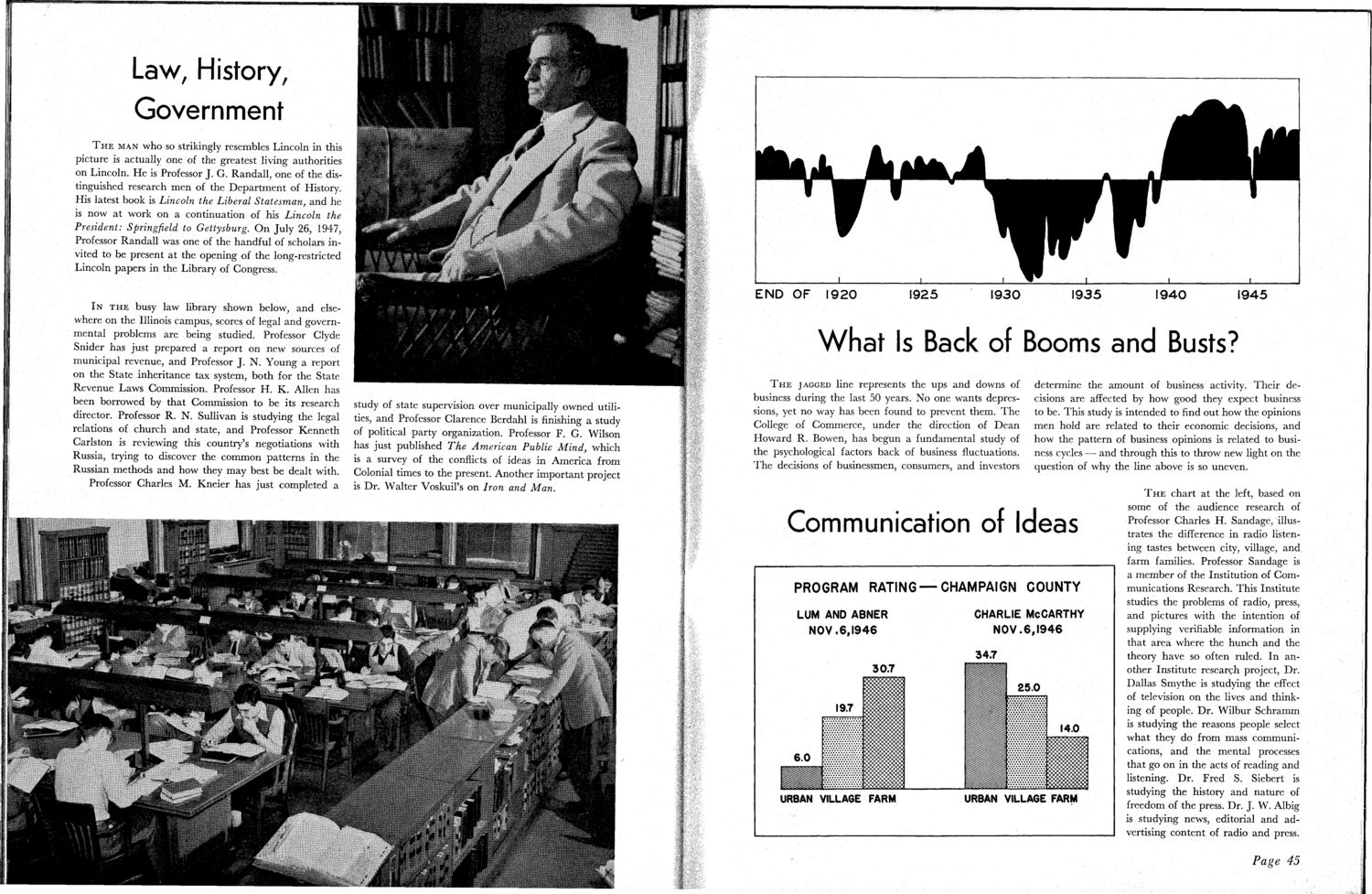| |
| |
Caption: Book - Research on Campus (1949)
This is a reduced-resolution page image for fast online browsing.

EXTRACTED TEXT FROM PAGE:
Law, History, Government T H E MAN who so strikingly resembles Lincoln in this picture is actually one of the greatest living authorities on Lincoln. H e is Professor J. G. Randall, one of the distinguished research men of the Department of History. His latest book is Lincoln the Liberal Statesman, and he is now at work on a continuation of his Lincoln the President: Springfield to Gettysburg. O n July 26, 1947, Professor Randall was one of the handful of scholars invited to be present at the opening of the long-restricted Lincoln papers in the Library of Congress. END OF I N T H E busy law library shown below, and elsewhere on the Illinois campus, scores of legal and governmental problems are being studied. Professor Clyde Snider has just prepared a report on new sources of municipal revenue, and Professor J. N. Young a report on the State inheritance tax system, both for the State Revenue Laws Commission. Professor H . K. Allen has been borrowed by that Commission to be its research director. Professor R. N. Sullivan is studying the legal relations of church and state, and Professor Kenneth Carlston is reviewing this country's negotiations with Russia, trying to discover the common patterns in the Russian methods and how they may best be dealt with. Professor Charles M. Kneier has just completed a 1920 1930 1935 1940 1945 What Is Back of Booms and Busts? study of state supervision over municipally owned utilities, and Professor Clarence Berdahl is finishing a study of political party organization. Professor F. G. Wilson has just published The American Public Mind, which is a survey of the conflicts of ideas in America from Colonial times to the present. Another important project is Dr. Walter Voskuil's on Iron and Man. T H E JAGGED line represents the ups and downs of business during the last 50 years. No one wants depressions, yet no way has been found to prevent them. T h e College of Commerce, under the direction of Dean Howard R. Bowen, has begun a fundamental study of the psychological factors back of business fluctuations. T h e decisions of businessmen, consumers, and investors determine the amount of business activity. Their decisions are affected by how good they expect business to be. This study is intended to find out how the opinions men hold are related to their economic decisions, and how the pattern of business opinions is related to business cycles — and through this to throw new light on the question of why the line above is so uneven. T H E chart at the left, based on some of the audience research of Professor Charles H. Sandage/illustrates the difference in radio listening tastes between city, village, and farm families. Professor Sandage is a member of the Institution of Communications Research. This Institute studies the problems of radio, press, and pictures with the intention of supplying verifiable information in that area where the hunch and the theory have so often ruled. In another Institute research project, Dr. Dallas Smythe is studying the effect of television on the lives and thinking of people. Dr. Wilbur Schramm is studying the reasons people select what they do from mass communications, and the mental processes that go on in the acts of reading and listening. Dr. Fred S. Siebert is studying the history and nature of freedom of the press. Dr. J. W. Albig is studying news, editorial and advertising content of radio and press. Communication of Ideas PROGRAM RATING —CHAMPAIGN COUNTY LUM AND ABNER NOV •6,1946 30.7 25.0 197 CHARLIE MCCARTHY NOV.6,1946 34.7 14.0 6.0 URBAN VILLAGE FARM URBAN VILLAGE FARM Page 45
| |